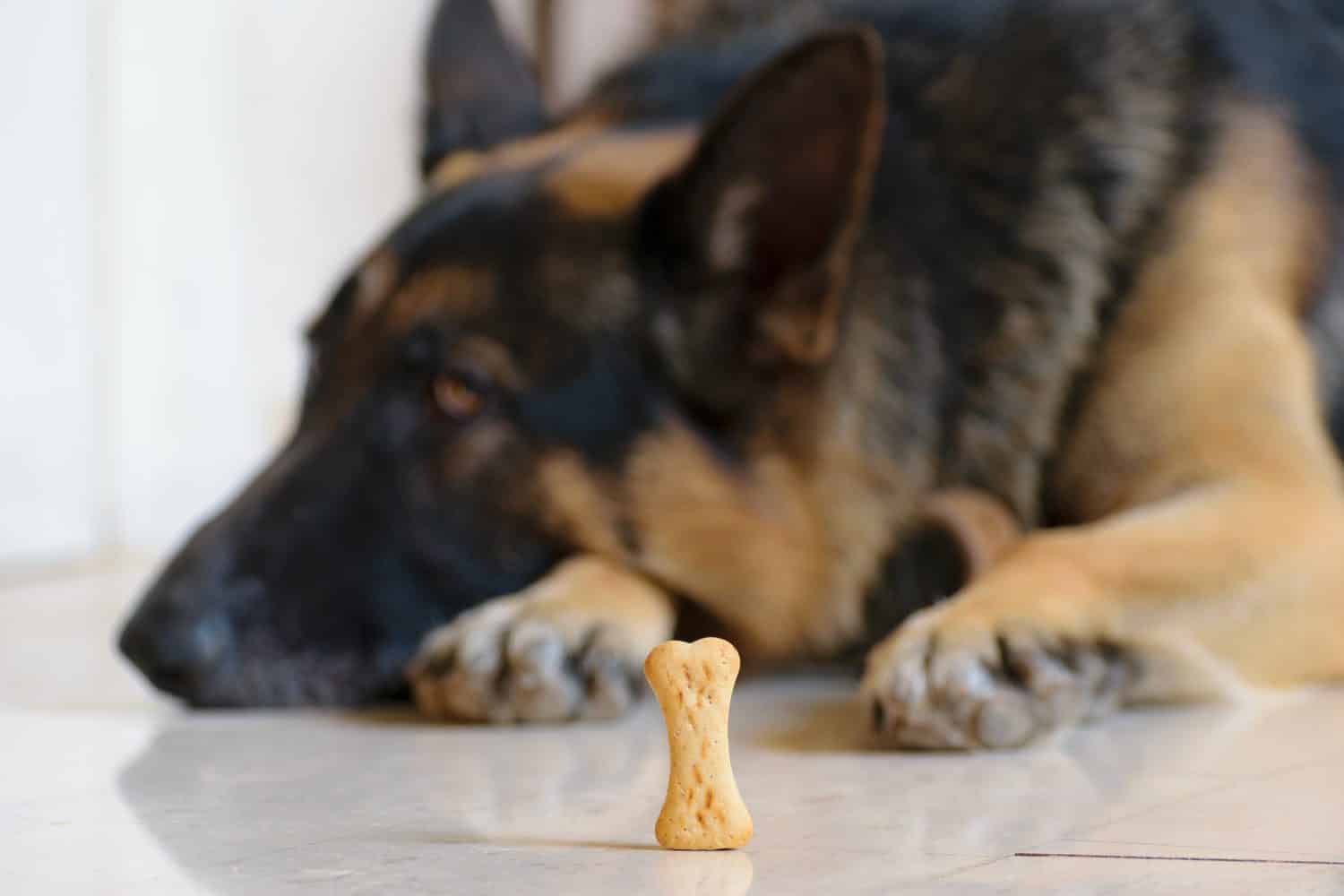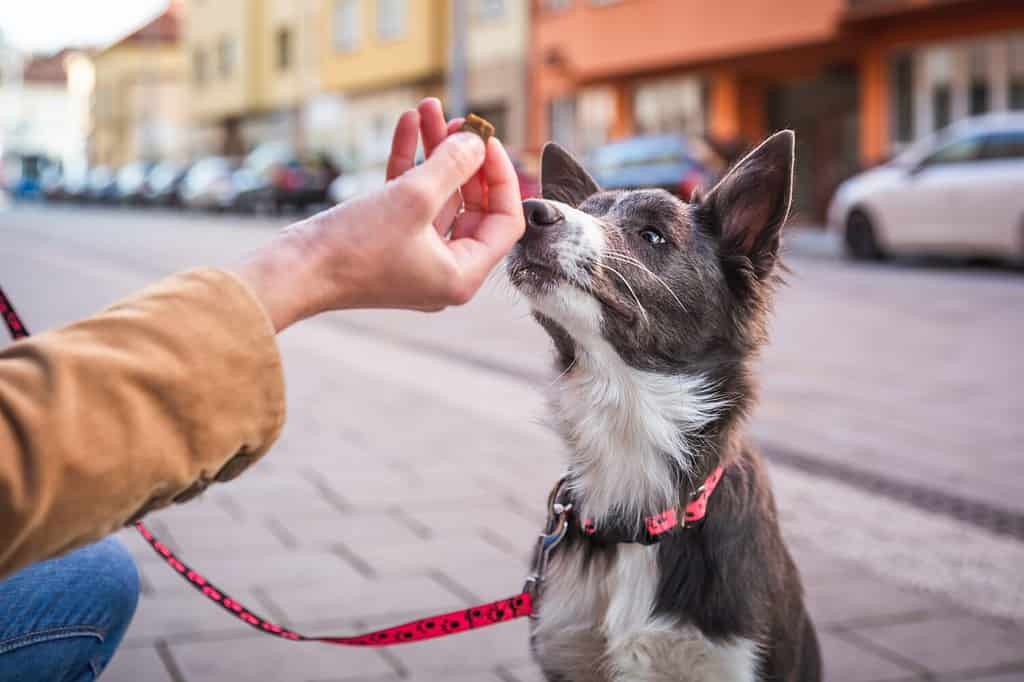“Leave it” is a fundamental skill that all dogs should learn. When you inevitably drop a pill on the floor or pass by something dangerous on your daily walk, this cue can save your dog’s life! So, how do you teach a dog to “leave it?”
Start by covering a treat. Let your dog nose and paw at your hand until they give up and leave the treat alone, then immediately mark and reward. Continue until they’re ignoring the treat you present, then move on to uncovered treats and slowly extend the duration of the “leave it” cue.
In this article, we’ll talk about how to teach your dog to “leave it” step by step.
#1: Start with the Treat Covered

Teaching your dog to “leave it” takes time and patience, because their instinct is to eat the food in front of them!
©CoinUp/Shutterstock.com
You’ll want to begin with a treat on the floor and your hand or foot covering it. Keep a second treat in a hand held behind your back.
Let your dog try to get the covered treat and wait for them to give up. They will likely sniff, nose, and paw at it. The moment they leave it alone, mark with a clicker or “yes!” and give them the treat you’re holding.
Continue practicing this until your dog automatically leaves the treat alone.
#2: Add the “Leave it” Cue
Once your dog is leaving the covered treat consistently, add your “leave it” cue. Repeat several times to ensure your dog understands.
#3: Teach them to Look Away From the Treat

At first, it’s okay for your dog to be completely focused on the treat, but over time you want to teach them to look away.
©ubaru/Shutterstock.com
At this point, your dog is likely still focusing heavily on the covered treat. They’re likely staring intently, maybe with some drool dripping onto the carpet.
Continue as you have been, but now wait for your dog to look away from the treat. The moment they do, even for a second, mark and reward. Repeat until your dog is consistently looking away when presented with the treat.
#4: Extend the Duration
Now your dog is becoming a pro at ignoring the covered treat, but likely only for a few seconds. You’ll want to extend the duration of your “leave it” cue by waiting slightly longer each time.
Remember to move slowly and not to expect too much! You don’t want to go from a ten-second wait to a five-minute one, because your dog will get bored and walk away.
#5: Try “Leave it” With the Food Uncovered
Now, try briefly uncovering the food–but keep your hand or foot close enough to cover it again. Your dog will likely try to grab for the treat since they’re still learning, and you don’t want them to be able to get it!
Begin by treating them immediately upon ignoring the treat and build up duration as you did when the treat was covered, until your dog has mastered the cue.
#6: Practice the Cue in Various Situations

Practice in a variety of situations and environments until your dog can easily walk past a scatter of treats on the ground.
©Kamix-studio/Shutterstock.com
Dogs aren’t good at generalization, which means they won’t necessarily know that “leave it” applies to things on the ground outside, or even in the kitchen instead of the living room.
You want your dog’s “leave it” cue to be flawless. To get there, you’ll need to practice in different environments, with different objects, and with different family members giving the cue. Gradually add more treats to increase the temptation.
Pair “leave it” with you dropping the treat and with walking by food on the ground. You can use a short leash in these situations to ensure they can’t grab the treat without permission!
As your dog learns, you may have to start at the beginning whenever you introduce something new.
#7: Have Patience
Keep in mind that this is a challenging skill for a dog to learn and that it takes time. You aren’t likely to teach your dog to “leave it” in one training session but over weeks or months of daily training.
Keep sessions short and fun, and feel free to skip a day if you or your dog isn’t feeling it. Whenever possible, end your training before either of you get frustrated or bored.
Remember to celebrate every small step along the way and don’t be too hard on yourself or your dog if it takes longer than you think it should. Before you know it, you’ll be looking back on this time with fondness, your well-trained pup by your side.
Thank you for reading! If you have feedback on this post, please contact the AZ Animals editorial team.
The photo featured at the top of this post is © CoinUp/Shutterstock.com
Ready to discover the top 10 cutest dog breeds in the entire world?
How about the fastest dogs, the largest dogs and those that are -- quite frankly -- just the kindest dogs on the planet? Each day, AZ Animals sends out lists just like this to our thousands of email subscribers. And the best part? It's FREE. Join today by entering your email below.
Thank you for reading! Have some feedback for us? Contact the AZ Animals editorial team.






